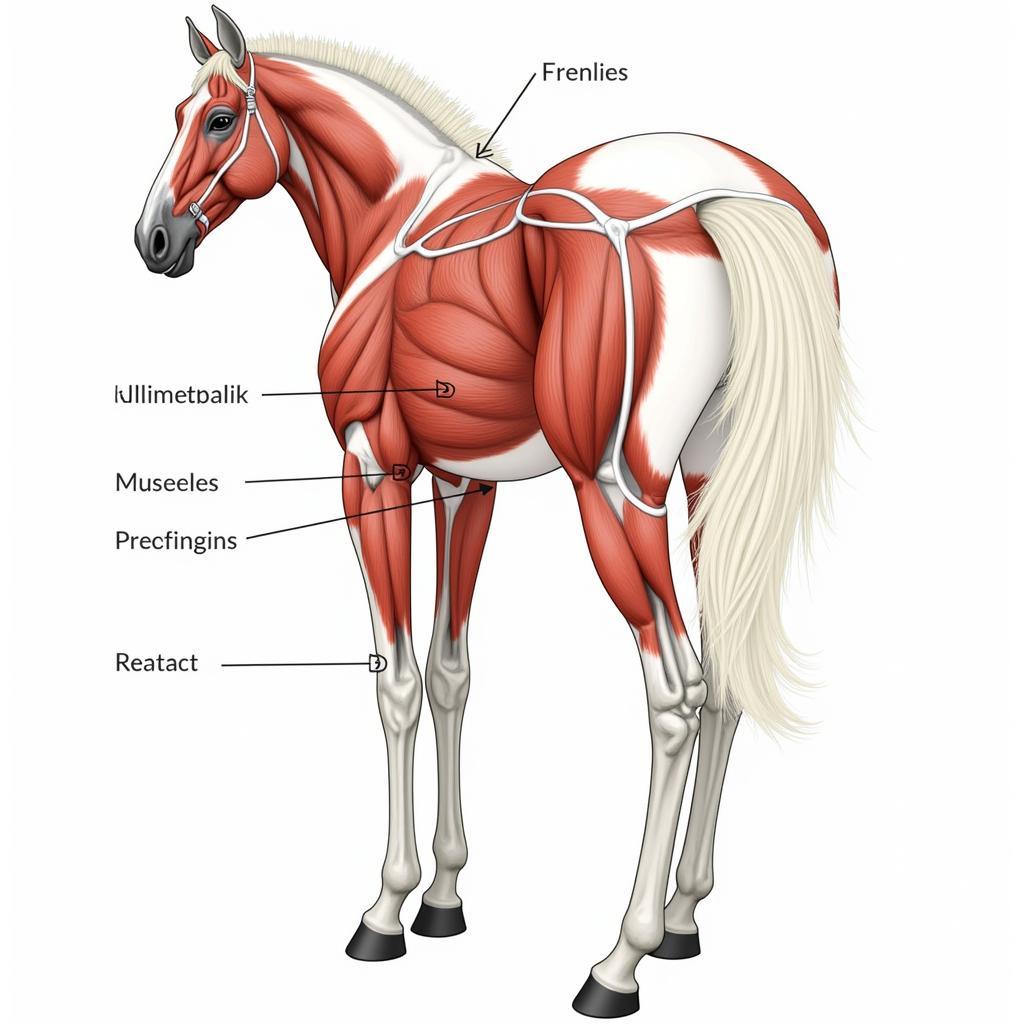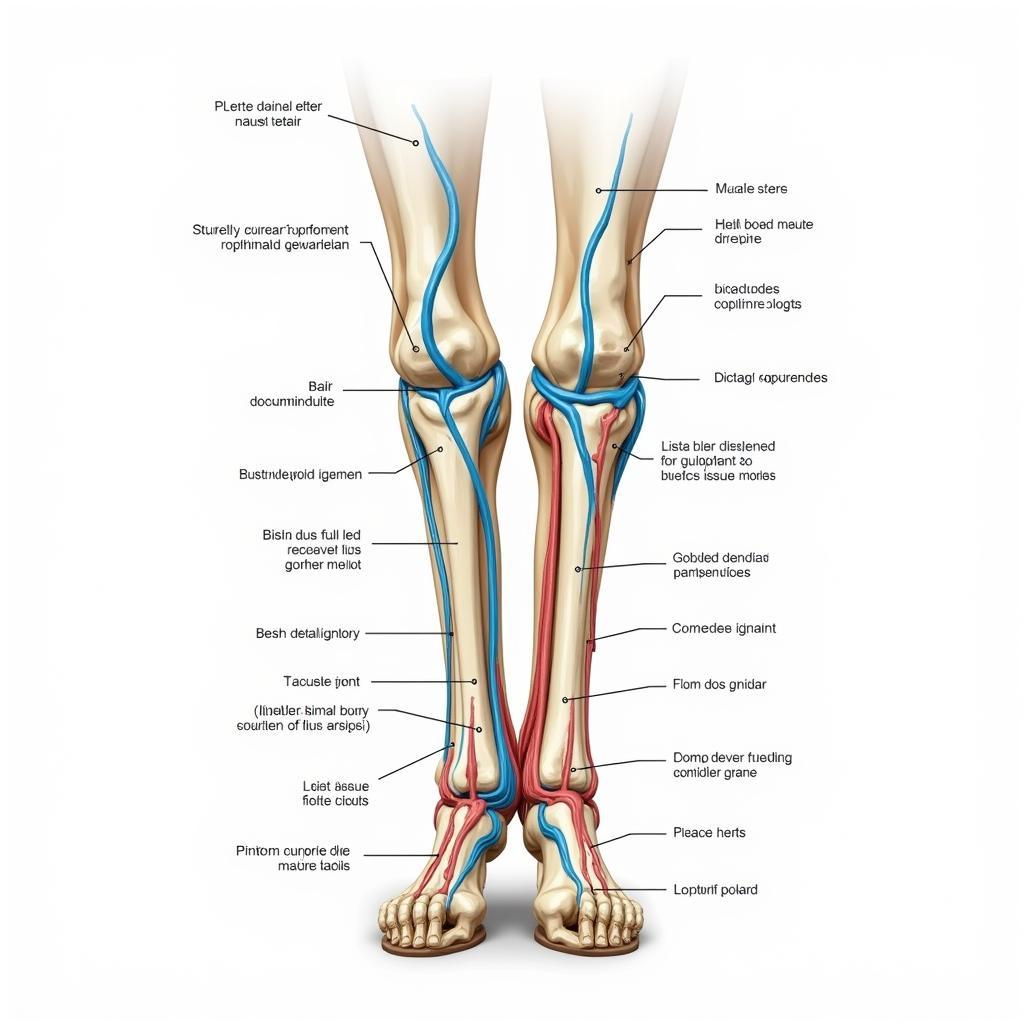Understanding Horse Front Leg Anatomy is crucial for any horse owner or enthusiast. A deep dive into the structure and function of these complex limbs will equip you with the knowledge to recognize potential problems, provide appropriate care, and appreciate the athleticism of these magnificent animals. Let’s explore the intricate world of horse front leg anatomy together.
The front legs of a horse, unlike human arms, support approximately 60% of their body weight. They are designed for locomotion, absorbing shock, and providing stability. The intricate network of bones, tendons, ligaments, and muscles work together seamlessly to facilitate movement. Each component plays a vital role in the horse’s ability to walk, trot, canter, gallop, and jump.
Key Bones in the Horse’s Front Leg
The horse’s front leg structure is remarkably complex. From the scapula (shoulder blade) to the phalanges (hoof bones), each bone contributes to the overall strength and flexibility of the limb. Understanding the individual bones is foundational to understanding horse front leg anatomy.
- Scapula: This large, flat bone forms the shoulder and connects the leg to the body.
- Humerus: The long bone of the upper arm, located between the scapula and the radius.
- Radius and Ulna: These two bones form the forearm. In horses, the ulna is fused to the radius.
- Carpal Bones (Knee): These small bones, similar to the human wrist, are crucial for shock absorption. horse leg x ray can provide detailed views of these bones.
- Metacarpal Bones (Cannon Bone and Splint Bones): The cannon bone is the main weight-bearing bone below the knee. The splint bones are smaller, vestigial bones that run along either side of the cannon bone.
- Phalanges (Pastern, Coffin, and Navicular Bones): These bones form the digit and are enclosed within the hoof.
 Horse Front Leg Muscles and Tendons
Horse Front Leg Muscles and Tendons
What are the main joints in the horse’s front leg?
The main joints in the horse’s front leg are the shoulder joint, elbow joint, carpus (knee) joint, fetlock joint, pastern joint, and coffin joint. These joints allow for a wide range of motion and are essential for the horse’s movement.
Dr. Emily Carter, a renowned equine veterinarian, emphasizes the importance of understanding these joints: “Recognizing the location and function of each joint is critical for diagnosing and treating lameness.”
Muscles and Tendons: The Engine of Movement
The muscles and tendons of the horse’s front leg are responsible for generating power and controlling movement. Key tendons include the superficial and deep digital flexor tendons, which play a vital role in flexing the lower leg and foot. kombat boots for horses can help protect these vital structures.
How do the muscles and tendons work together?
Muscles contract to generate force, which is then transmitted to the bones through the tendons. This coordinated action produces movement. Damage to any of these structures can significantly impact the horse’s performance.
 Horse Front Leg Ligaments and Connective Tissue
Horse Front Leg Ligaments and Connective Tissue
Ligaments: Providing Stability and Support
Ligaments connect bones to bones, providing stability to the joints and preventing excessive movement. The suspensory ligament, for example, plays a crucial role in supporting the fetlock joint.
Common Injuries and Conditions
Understanding horse front leg anatomy can help you identify potential problems. Common injuries include:
- Tendonitis: Inflammation of a tendon.
- Ligament injuries: Sprains or tears of ligaments.
- Fractures: Breaks in the bones.
- Arthritis: Degeneration of the joints.
Conclusion
A comprehensive understanding of horse front leg anatomy is invaluable for anyone involved with horses. By recognizing the intricate structures and functions of this complex limb, you can provide optimal care, recognize potential problems, and truly appreciate the athleticism of these magnificent creatures. Knowledge of horse front leg anatomy empowers you to be a better horse owner, caretaker, or enthusiast. For a different perspective, consider looking at 3d horses. For those interested in Western riding, check out these stylish horse riding western boots. You can also admire the artistry of remington horse sculpture.
FAQ
- What is the most common injury in a horse’s front leg?
- How can I prevent injuries to my horse’s front legs?
- What are the signs of a front leg injury in a horse?
- How is a front leg injury in a horse diagnosed?
- What are the treatment options for a front leg injury in a horse?
- How long does it take for a horse’s front leg injury to heal?
- What is the prognosis for a horse with a front leg injury?
Need further assistance? Contact us at Phone: 0772127271, Email: [email protected] Or visit us at QGM2+WX2, Vị Trung, Vị Thuỷ, Hậu Giang, Việt Nam. Our customer care team is available 24/7.